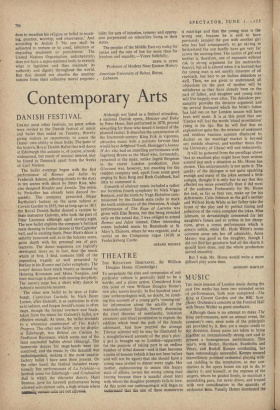Contemporary Arts
DANISH FESTIVAL
UNLIKE most other festivals, no guest artists were invited to the Danish festival of music and ballet that ended on Tuesday, thereby giving visitors an opportunity to assess the Danes' own ability in these fields. The fame of the historic Royal Danish Ballet that will dance at Edinburgh this autumn is, of course, already widespread, but much of musical interest may be found in Denmark apart from the Ivorks of Carl Nielsen.
The ballet evenings' began with the first performance of Romeo and Juliet by Frederick Ashton, adhering closely to the story in ten scenes with decor by Peter Rice, who also designed Rinaldo and Armide. The music by Prokofiev has already been danced fre- quently. The company presented Birger Bartholin's fantasy on the same subject at Covent Garden in 1953, but as long ago as 1811 the Royal Danish Ballet danced a version by their instructor qaleotti, who took the part of Friar Laurence although aged seventy-eight. The new ballet exploits the company's brilliant male dancing in formal dances at the Capulets' ball, and in exciting duels. Peter Rice's decor is suitably luxuriant and, as in the balcony scene, gains depth with his personal use of grey traceries. The dance sequences are logically developed, more so, in fact, than the music which at first, I find, contains little of the impending tragedy so well presented by Berlioz in his Romeo and Juliet symphony. The lovers' dances have much beauty, as danced by Henning Kronstam and Mona Vangsaa, and their marriage is shown with moving simplicity. The nurse's page has a short witty dance in Ashton's inimitable manner.
The other new ballet to be seen at Edin- burgh, Capricious Lucinda, by Niels Bjorn Larsen, after Galeotti, is as capricious in style as in subject, and Jorgen Jersild's music is often inapt, though the formal overture and finale, taken from the music for Galeotti's ballet, are effective enough. At times, the ballet amounts to a whimsical counterpart of . The Rake's Progress. The other new ballet, not for display at Edinburgh, was Behind the Curtain by Fredbjorn Bjornsson, which seems one of the least successful ballets about rehearsal. The humorous dances for stage-hands were too contrived, and the music by Ole Schmidt was undistinguished, making it the most unsatis- factory ballet I have seen them present. On the other hand, the festival included excep- tionally fine performances of La Sylphide—a Scottish scene for Edinburgh—and Graduation Ball in which the chhracter dancer, Hans Brenaas, gave his farewell performance being allowed solo curtain calls, a high tribute where uggsgaL4 curtain calls are not allowed. Although not listed as a festival attraction, a national Danish opera, Minister and Duke by Peter Heise, first performed in 1878, proved rewarding for those who heard it instead of the planned recital. It describes the assassination of the fourteenth-century King Erik in vigorous, attractive music with a patriotic fervour that would have delighted Verdi. Honegger's Jeanne D' Arc also had an impelling performance with Ingeborg Brams as the Maid who, fortunately, remained at the stake, unlike Ingrid Bergman in the recent London production. Don Giovanni was, however, too exacting for the resident company and, apart from some good singing by Kim Borg and Ruth Guldbaek, had little to commend it.
Concerts of abstract music included a rather too formless fourth symphony by Niels Viggo Bentzon, and the ninth by Vagn Holmboe com- missioned by the Danish state radio to mark the tenth anniversary of the liberation. A single performance of. The Rape of Lucretia was given with Else Brems, but this being revealed only on the actual day, I was obliged to attend Borneo and Juliet instead. Other interesting events included music by Buxtehude at St. Mary's, Elsinore, where he was organist, and a recital on the Compenius organ (1610) at Frederiksborg Castle.
OERARD BOURKE


































 Previous page
Previous page